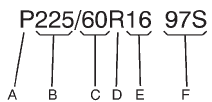Tire Designations
Tire Size
The following is an example of a typical passenger vehicle tire size.

(A) Passenger (P-Metric) Tire:
The United States version of a metric tire sizing system. The letter P as the first character in the tire size means a passenger vehicle tire engineered to standards set by the U.S. Tire and Rim Association.
(B) Tire Width: The three-digit number indicates the tire section width in millimeters from sidewall to sidewall.
(C) Aspect Ratio: A two-digit number that indicates the tire height-to-width measurements.
For example, if the tire size aspect ratio is 60, as shown in item C of the illustration, it would mean that the tire's sidewall is 60 percent as high as it is wide.
(D) Construction Code: A letter code is used to indicate the type of ply construction in the tire. The letter R means radial ply construction; the letter D means diagonal or bias ply construction; and the letter B means belted-bias ply construction.
(E) Rim Diameter: Diameter of the wheel in inches.
(F) Service Description: These characters represent the load index and speed rating of the tire. The load index represents the load carrying capacity a tire is certified to carry. The speed rating is the maximum speed a tire is certified to carry a load.
See also:
USB Port
For vehicles with a USB port, the
following devices may be connected
and controlled by the infotainment
system.
• iPods
• PlaysForSure Devices (PFDs)
• USB Drives
• Zunes™
• USB ...
Radio Data System (RDS)
The audio system has a Radio Data System (RDS). RDS features are available for
use only on FM stations that broadcast RDS information. With RDS, the radio can:
Seek to stations broadcasting the ...
Traction Control System (TCS)/StabiliTrak® Light
The StabiliTrak or Traction Control System (TCS) indicator/warning light comes
on briefly when the engine is started.
If the light does not come on, have the vehicle serviced by your dealer. If t ...


